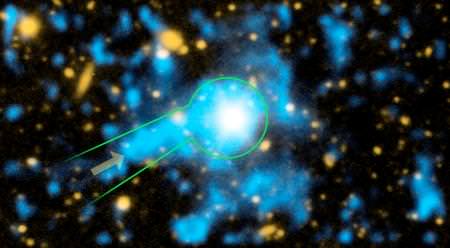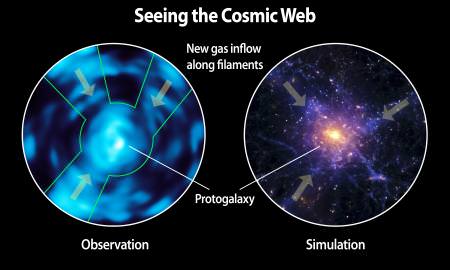An international team of astronomers has taken unprecedented images of intergalactic space — the diffuse and often invisible gas that connects and feeds galaxies throughout the Universe.
Until now, the structure of intergalactic space has mostly been a matter for theoretical speculation. Advanced computer simulations predict that primordial gas from the Big Bang is distributed in a vast cosmic web — a network of filaments that span galaxies and flow between them.
This vast network is impossible to see alone. In the past astronomers have looked at distant quasars — supermassive black holes at the centers of galaxies which are rapidly accreting material and shining brightly — to indicate the otherwise invisible matter along their lines of sight.
While distant quasars may reveal the otherwise invisible gas, there’s no information about how that gas is distributed across space. New images, however, from the Cosmic Web Imager are revealing the webs’ filaments directly, allowing them to be seen across space.
The first filaments observed by the Cosmic Web Imager are in the vicinity of two ancient but bright objects: the quasar QSO 1549+19 and a so-called Lyman alpha blob (yes, this is a technical term for a huge concentration of hydrogen gas) in the emerging galaxy cluster SSA22. These objects are bright, lighting up the intervening galactic space and boosting the detectable signal.

Image Credit: Christopher Martin, Robert Hurt
Both objects date back to two billion years after the Big Bang, in a time of rapid star formation in galaxies. Observations show a narrow filament, about one million light-years across flowing into the quasar, which is likely fueling the growth of the host galaxy.
There are three filaments flowing into the Lyman alpha blob. “I think we’re looking at a giant protogalactic disk,” said lead author Christopher Martin from the California Institute of Technology in a press release. “It’s almost 300,000 light-years in diameter, three times the size of the Milky Way.”
The Cosmic Web Imager on board the Hale 200 inch telescope is a spectrographic imager, taking pictures at many different wavelengths simultaneously. This allows astronomers to learn about objects’ composition, mass and velocity.
“The gaseous filaments and structures we see around the quasar and the Lyman alpha blob are unusually bright,” said Martin. “Our goal is to eventually be able to see the average intergalactic medium everywhere. It’s harder, but we’ll get there.”
Both papers (“Intergalactic Medium Observations with the Cosmic Web Imager: I. The Circum-QSO Medium of QSO 1549+19 and Evidence for a Filamentary Gas Inflow” and “Intergalactic Medium Observations with the Cosmic Web Imager: II. Discovery of Extended, Kinematically-linked Emission around SSA22 Ly-alpha Blob 2”) have been published in the Astrophysical Journal.


Shannon, do you know if these gas filaments correlate spatially at all with the Dark Matter filaments thought to provide the framework of the largest scale structures?
I guess I’m wondering the same thing. What’s the relationship, if any, between the gas filaments and the presumed dark matter webbing?